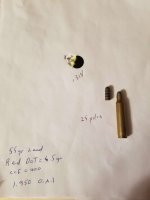Good start! A 100-yard group would be good to see if you can find a day without wind to shoot it.
The main issue with lead in rifle barrels is the potential for fouling that must be removed completely before firing full-power jacketed bullets in the gun again. Shooting jacketed bullets through a lead-fouled bore, despite some folks thinking it's a great way to clean bores, has caused barrel bulging and frame stretching in some revolvers. The lead acts like high viscosity grease at bullet speeds and can raise pressure just as easily as a bore full of grease can. At high power rifle pressures, there is potential to do significant damage.
For that reason, it is important that before you fire jacketed bullets again, that you use a good lead-removing bore cleaner. I like No-Lead because it is done in an hour. Other lead cleaners I've used really need to sit at least overnight, then be brushed and patched out and the process repeated a couple of times before the bore is really clean. The old Foul Out electrolytic bore cleaners were really good at this, but they are no longer made.
Please note the board rules prohibit posting copyrighted material except under some specific circumstances. I put a link to those rules in your post.

